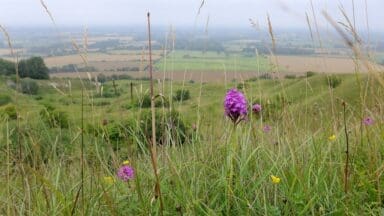
Agreed at COP15 in 2022, the government committed to halting and reversing biodiversity loss and protecting at least 30% of land and sea for nature by 2030. In the UK, delivering on this means restoring nature across a network of well-managed, legally protected areas and is critical to tackling both the climate and nature crises.
However, the 30by30: 2025 UK Progress Report indicates that with just five years to go, progress has stalled by challenges including: a failure to designate new sites for nature, uncertainty in nature friendly farming policy, and continued underfunding for site restoration.
The analysis paints a stark picture. The report shows that in England, ust 2.83% of land is effectively protected and managed for nature – a decline from 2.93% in 2024. Across the other nations of the UK, the data shows a similar pattern with just 2.14% of land in good condition in Wales, 4% in Northern Ireland and 12.63% in Scotland.
Richard Benwell, CEO at Wildlife and Countryside Link, said: “The UK risks missing its 30by30 nature target by a country mile. Protecting 30% of land and sea isn’t a luxury, it’s vital for wildlife, our health, and the economy. This snail’s pace progress shows the UK governments have neglected nature for too long.”
The report found that problems blocking progress nature recovery include:
- Pace of adding new protected areas remains far too slow.
- Poor condition of designated sites as many protected areas are still damaged or degraded due to insufficient or inappropriate management.
- Destructive practices are still allowed in some of our most important places for wildlife.
- Lack of monitoring. Governments often don’t have the data they need to track biodiversity or plan recovery.
Conservationists warn that the UK risks missing its target by a ‘country mile’ and charities are calling on Ministers to deliver a rapid rollout of new designations, backed by proper funding, stronger nature protection, and robust monitoring to turbocharge nature recovery nationwide.
Benwell added: “There’s still chance to meet the target but only if Ministers get moving. In England, good policies like nature-friendly farming payments, the Land Use Framework, and radical reform of the water system are on the table, but 2025 must be the year when promises make way for delivery. We need more nature sites in better condition and a crack down on pollution and unsustainable development. The price of failure is terrible for people and wildlife, but the prize of success will be a thriving, healthy society that’s rich in nature.”
Deborah Long, Chief Executive of Scottish Environment Link, said: “Scotland’s biodiversity is amongst the least resilient in the world and the more we can do to restore nature, the more we build a better future for all of us. 30×30 offers us an opportunity to reconnect nature and build its resilience in the ongoing crisis, but the new report shows we are not where we need to be yet. Effective nature restoration is for everyone – it means a better quality of life for all, as well as resilient local livelihoods. We need to keep the pressure on our governments to ensure that this vision is realised.”
Max Bryant, CEO of Northern Ireland Environment Link, added: “Unfortunately it has been clear for a while that we are not doing enough to protect our environment. We only have to look at the state of our rivers and lakes to see that this is the case. This timely report shows that we have even further to go in NI to meet our targets than many may have anticipated. Amongst other things, NI needs long term, legally binding and fully funded targets to better protect our biodiversity and public health. Earlier this year the Office for Environmental Protection recommended that DAERA should consider proposing legislation for setting statutory targets to increase the extent and condition of protected sites. We are still waiting for that to happen. We need all of the Executive parties to co-operate on this and support the AERA Minister and NIEL would be happy to work with all parties to help meet our targets and better protect our environment.”
Karen Whitfield, Director of Wales Environment Link, said: “Whilst the Welsh Government has recognised a nature crisis, action too often falls short of the scale, priority and investment necessary to turn it around. Designations by themselves do not restore wildlife; the way they are monitored and managed is crucial to nature’s recovery and will only happen with a step change in the way environmental investment is prioritised. Our Pathways to 2030 report sets out the need for investment of £438m a year to restore Welsh nature; this is only 1.7% of the 2025/26 Welsh Government budget, so entirely possible if Welsh Ministers decide to prioritise nature’s recovery.”

